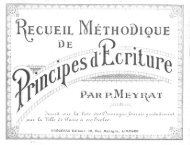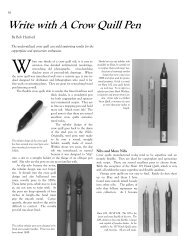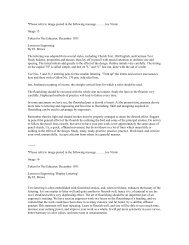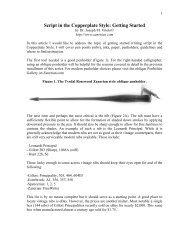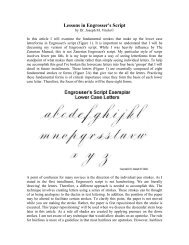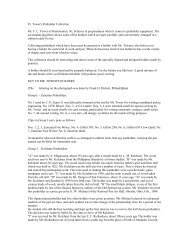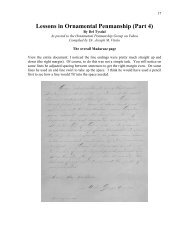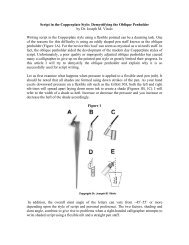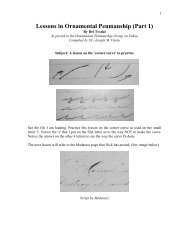The Educator (Volume 45) - IAMPETH
The Educator (Volume 45) - IAMPETH
The Educator (Volume 45) - IAMPETH
You also want an ePaper? Increase the reach of your titles
YUMPU automatically turns print PDFs into web optimized ePapers that Google loves.
<strong>The</strong> ability to write a plain business<br />
hand should be acquired by<br />
everyone. <strong>The</strong>re is a very great demand<br />
for good handwriting today,<br />
especially in the schools and business<br />
offices. At some time or other everyone<br />
is required to do some writing,<br />
and to not be able to write so that<br />
others can read it, is a mark of carelessness<br />
or lack of ability, for the<br />
average person can acquire a legible<br />
style of writing with a little systematic,<br />
well-directed effort.<br />
<strong>The</strong> lessons in <strong>The</strong> <strong>Educator</strong> are<br />
planning to assist everyone who so<br />
desires to improve his writing. <strong>The</strong>y<br />
are also presented with the view of<br />
aiding teachers to teach handwriting.<br />
Good business writing still has commercial<br />
value and we predict that<br />
more attention will have to be given<br />
to penmanship by those who seek<br />
positions.<br />
A good position showing the right<br />
hand in action. Notice the evenness of<br />
the shoulders due to the fact that the<br />
elbows are on the desk. Notice how<br />
the head is held upright.<br />
Neatness<br />
One of the characteristics of good<br />
writing is neatness. Any student can<br />
cultivate the habit of neatness and<br />
care. Always endeavor to make your<br />
writing look neat,—this means nice<br />
margins, no corrections, blots or<br />
smeared places. It also means<br />
smooth clean lines. A blotter under<br />
the hand will help keep the paper<br />
clean. Care in dipping ink will also<br />
avoid ink blots. Dip so that the eye<br />
of the pen is covered but do not get<br />
any ink on the holder.<br />
Business Writing<br />
By E. A. Lupfer<br />
No. 1<br />
<strong>The</strong> Angle of the Paper<br />
<strong>The</strong> paper should be held in front<br />
of you with the top slanting slightly<br />
towards the left (for right-handed<br />
persons). <strong>The</strong> lines on the paper<br />
should be parallel to an imaginary<br />
line drawn from the lower left to the<br />
upper right hand corners of the desk.<br />
<strong>The</strong> paper should be shifted as often<br />
as necessary in order to keep the<br />
writing directly in front of the body.<br />
When writing at the top of the page<br />
the paper should be slid down, and<br />
when writing at the bottom of the<br />
page the paper should be moved up<br />
in order to keep the writing directly<br />
in front of the body. <strong>The</strong> left-handed<br />
writer should slant his paper toward<br />
the right just the opposite to that of<br />
a right-handed writer.<br />
Movement<br />
A combination of movements is desirable.<br />
A pure finger movement<br />
produces slow writing. Whole arm<br />
movement tends to carelessness. <strong>The</strong><br />
arm rolls on the muscles below the<br />
elbow in making letters. <strong>The</strong> hand<br />
glides on the little finger freely on<br />
the upward stroke but rests on the<br />
downward stroke. In some places the<br />
fingers may assist in guiding the pen.<br />
To develop free movement and get<br />
the idea of how the muscles act, place<br />
the arm on the desk in the writing<br />
position, close the hand tightly and<br />
while pressing on the muscles roll<br />
the arm around quickly forming an<br />
oval exercise. In a few minutes you<br />
will discover the set of muscles used<br />
in making most of the capitals. At<br />
first one may write slowly while<br />
gaining a knowledge of form, but it<br />
is a good plan to work form and<br />
movement together.<br />
Position<br />
It is important to study position<br />
in acquiring any skill. This is especially<br />
true in penmanship. We should<br />
consider position from the standpoint<br />
of the health of the writer and also<br />
from the standpoint of efficiency.<br />
Sit well back in the chair, leaning<br />
forward from the hips. Keep the<br />
back comparatively straight and not<br />
touching the desk. Hold the head up<br />
which never should be turned sideways.<br />
<strong>The</strong> elbows should be on the<br />
edge of the desk. <strong>The</strong>y should be<br />
even. That is, do not shove one<br />
elbow forward on the desk and the<br />
other one off the desk. By keeping<br />
the elbows evenly on or off the desk,<br />
you keep the shoulders even and<br />
therefore, maintain a more healthful<br />
position. <strong>The</strong> eyes should not be too<br />
close to the work. By having a natural<br />
easy position, with the shoulders<br />
even, the head up and the back<br />
straight, you will get better circulation<br />
of the blood and find this will<br />
enable you to work at a desk for<br />
many hours without injury to health.<br />
<strong>The</strong> arm should rest on the muscle<br />
below the elbow. <strong>The</strong> knuckle should<br />
point towards the ceiling. It is a<br />
good thing to keep the wrist comparatively<br />
flat. It may slope slightly,<br />
but be sure not to let the hand turn<br />
on the side. <strong>The</strong> weight of the hand<br />
should rest on the third and fourth<br />
fingers. <strong>The</strong> fingers should be curved<br />
naturally. <strong>The</strong> first finger should rest<br />
on top of the holder and the second<br />
finger should rest underneath the<br />
holder which should cross the finger<br />
at the base of the nail. <strong>The</strong> first and<br />
second fingers and thumb should be<br />
about evenly distributed around the<br />
holder. <strong>The</strong> first finger should always<br />
extend down lower than the end of<br />
the thumb. If the first finger is<br />
pulled back of the thumb a cramped<br />
position will result. <strong>The</strong> main thing<br />
to keep in mind in regard to the<br />
hand is to have an easy natural position<br />
with no part of the hand tight.<br />
<strong>The</strong> penholder should point somewhere<br />
between the shoulder and<br />
elbow.<br />
This side view shows the proper position<br />
of the body. Notice that the body<br />
is held in healthy position — not<br />
cramped over.



